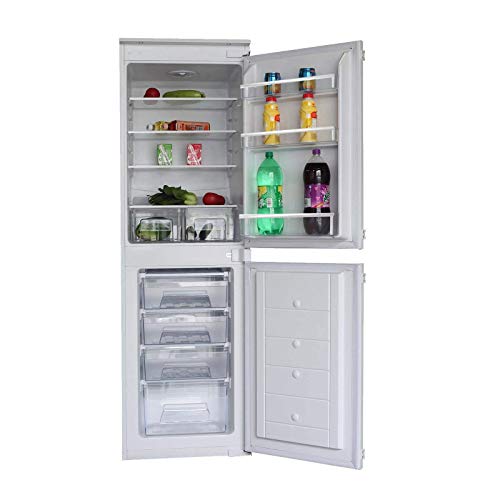Understanding Fridges and Freezers: The Essential Kitchen AppliancesRefrigerators and freezers are two of the most important devices in contemporary cooking areas. These appliances serve a vital role in food conservation and waste decrease by making sure that disposable products remain fresh and safe for usage. This post delves into the various kinds of fridges and freezers, their functionalities, and important considerations for selection and upkeep.Types of RefrigeratorsThe marketplace offers a variety of refrigerator types, each developed to fulfill various consumer needs. Below is a list of the most typical types of fridges:
- Top-Freezer Refrigerators
- Most typical type.
- Freezer compartment is situated above the refrigerator section.
- Normally more budget-friendly and energy-efficient.
- Bottom-Freezer Refrigerators
- Freezer lies at the bottom.
- Enables simpler access to fresh products at eye level.
- Often includes pull-out drawers for better company.
- Side-by-Side Refrigerators
- Refrigerator and freezer areas are nearby.
- Ideal for narrow kitchens and allows simple access to both compartments.
- Typically comes with water and ice dispensers.
- French Door Refrigerators
- Combines a bottom freezer with double doors at the top.
- Offers ample storage and elegant styles.
- Often consists of functions like temperature-controlled drawers.
- Compact Refrigerators
- Smaller size perfect for limited spaces.
- Frequently utilized in dormitory, small apartments, or as secondary fridges.
Table 1: Comparison of Refrigerator TypesTypeAdvantagesDisadvantagesTypical SizeTop-FreezerBudget-friendly, energy-efficientLess hassle-free access to the freezer14-30 cu. ft.Bottom-FreezerMuch easier access to fresh foodFreezer can be harder to arrange19-30 cu. ft.Side-by-SideEasy gain access to, water/ice dispenserNarrow vs. storage space22-30 cu. ft.French DoorTrendy, roomy, arrangedMore pricey20-30+ cu. ft.CompactSpace-saving, portableRestricted storage1.7-5.5 cu. ft.Types of FreezersFreezers are a similarly crucial appliance for food conservation. They can be found in various styles developed to fit various household needs. Consider the list below types:
- Upright Freezers
- Operate like a standard refrigerator with vertical storage.
- Simpler to arrange with racks and compartments.
- Chest Freezers
- Large, horizontal style usually using more storage area.
- Maintains temperature levels better throughout power interruptions.
- More energy-efficient than upright models.
- Portable Freezers
- Compact units perfect for outside activities or little areas.
- Often utilized for camping trips or as momentary storage.
Table 2: Comparison of Freezer TypesTypeBenefitsDownsidesNormal SizeUpright FreezerSimpler to organizeLess energy-efficient, more floor area5-20 cu. ft.Chest FreezerHolds more products, energy-efficientHarder to organize5-25 cu. ft.Portable FreezerCompact and versatileMinimal storage capability1-10 cu. ft.Key Features to ConsiderWhen picking a fridge or freezer, customers should bear in mind a number of functions that can boost performance:
- Energy Efficiency: Look for designs with the ENERGY STAR accreditation to conserve on electrical power expenses.
- Storage Capacity: Evaluate storage requirements based upon family size and consuming practices.
- Temperature level Control: Some home appliances offer digital controls for precise temperature settings.
- Adjustable Shelving: Customizable shelving permits optimal company.
- Water and Ice Dispenser: Offers benefit however can take up important space inside.
- Sound Level: Sound ratings can affect comfort, particularly in open-concept homes.
Advantages and disadvantages of Having a Fridge and FreezerWhile fridges and freezers are indispensable technologies, they likewise have specific advantages and disadvantages:ProsConsPreserve food lifespan and reduce wasteRequire routine upkeepPermit bulk purchasing and meal preppingCan be pricey to purchase and runDeal convenience and quick access to foodInhabit substantial kitchen areaMaintenance TipsTo ensure durability and optimum performance of fridges and freezers, consider the following upkeep ideas:
- Regular Cleaning: Clean the exterior and interior periodically to avoid buildup of dirt and germs.
- Check Seals: Inspect door seals frequently for leakages to keep performance.
- Temperature level Settings: Keep the fridge at 34-38 ° F and the freezer at 0 ° F for optimum food preservation.
- Thaw as Needed: Chest freezers need to be thawed regularly to keep performance.
- Clear Air Vents: Ensure that airflow isn’t obstructed to enhance energy efficiency.
Frequently asked questions About Fridges and FreezersQ1: How long can food be stored in a freezer?A: Most foods can be kept in a freezer for several months. Meats and poultry typically last 4-12 months, while veggies can last as much as 8-12 months. Q2: How frequently need to I clean my fridge and freezer?A: It is suggested to clean your fridge and freezer every 3 to 6 months, or as required when spills happen. Q3: Can I put hot food straight in the fridge?A: It is recommended to cool hot food to space temperature level before putting it in the fridge to prevent
raising the temperature inside the appliance. Q4: Why is my fridge running constantly?A: This might be due to a malfunctioning thermostat, blocked coils, or door seals that aren’t working correctly. Fridges and freezers are indispensable
properties to modern-day families, providing necessary services for food storage and preservation.Understanding the various types, functions, and upkeep requirements can help customers choose the ideal appliances for their requirements and maximize their performance. Accepting energy-efficient models not only supports sustainable practices but likewise contributes to significant cost savings on utility expenses, making informed options more important than ever.
